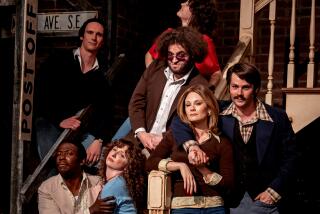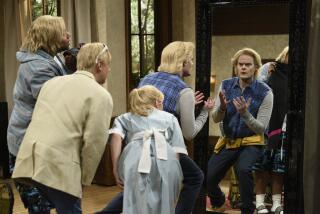HEY, REMEMBER WHEN?
- Share via
When “Samantha Who?” co-creator and executive producer Donald Todd initially pitched the idea of a comedy about a sweet amnesiac who finds out she was somewhat delinquent in her previous life, the idea of using flashbacks as a regular part of the ABC series didn’t occur to him.
“I was trying to do something that was fairly device-free, and in single-camera you find that you need more devices to tell your story than in multi-camera,” Todd explains, adding that once it was incorporated, “we could show that she could get more of her memory back and therefore grow.”
The now-canceled “Samantha Who?” was one of a handful of prime-time network series this season that incorporated the flashback -- despite its maligned wavy-line reputation -- to great comedic effect. “Ugly Betty,” “Scrubs,” “My Name Is Earl,” “How I Met Your Mother” and “30 Rock” all have used the device for character exposition and joke delivery.
“I think [flashbacks have] been in the language of the show from the beginning,” says “30 Rock” star and show-runner Tina Fey. “A lot of times they were jokes, but they were also reinforcing character traits of people who were still new for our audience. Now that those characters are well established, [the flashbacks] are really just jokes.”
“How I Met Your Mother,” which has been basically one flashback over its three seasons, uses the technique as a method for mimicking real-life conversations, according to creator Carter Bays. “The flashbacks allow us to have the characters ask the questions that the audience might want to ask,” he says. “They can interrupt the action to interject something.”
The rapid cuts of flashbacks serve as a way to quicken a show’s pace, even though it can add significantly to production budgets. “It absolutely helps in the storytelling,” Todd says. “We have a reduced amount of time every year, and comedy’s biggest problem as a genre is that it’s 21 minutes long with four act breaks. So you’re trying to tell a coherent story in little, tiny chunks.”
“The challenge is always with the budget, with the time you’re given to make a show that moves and feels exciting,” Bays says. “Flashbacks allow us to cut around from one set to another very quickly and gives a sense of real emotion and momentum to a story.”
Fey says the key is choosing the moments judiciously. “For example, something like Tracy Jordan saying, ‘Do you know who I am? Seriously, please tell me who I am!’ in the ball pit at the Chuck E. Cheese is a joke that we like, but it’s also a simple enough two-walled set. It felt like, ‘OK, this is the balance of finance versus joke. It’s worth doing it.’ ”
“Our flashback changes take two hours,” Todd adds. Christina Applegate’s “makeup and her wardrobe and all the things that make Bad Sam take time. We would do it more if we had more production time.”
Although flashbacks and voice-overs once helped shows like “MASH” break out of the sitcom mold, credit a shift in popular culture for making the technique more prevalent, particularly in comedy. “I think once upon a time in a sitcom, you’d just let the words speak for themselves, but I feel like we have a much more visual style,” Bays says. “If someone says something happened, you want to see it.”
“It’s a move that we have subconsciously lifted from ‘The Simpsons’ -- except it doesn’t cost more in animation,” Fey explains.
But Todd sees the flashback as being rooted in dramas and horror movies more than comedy. “They’re more the way that Jason Bourne got his flashbacks. They’re sharp, electrical pains and memories that come flooding back. Or the way in a horror movie that somebody recovers a memory that was awful,” he says, then pauses. “We hope we’re funnier than that.”
--
More to Read
The complete guide to home viewing
Get Screen Gab for everything about the TV shows and streaming movies everyone’s talking about.
You may occasionally receive promotional content from the Los Angeles Times.






